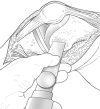The peel in total knee revision: exposure in the difficult knee
- PMID: 20574805
- PMCID: PMC3008911
- DOI: 10.1007/s11999-010-1431-4
The peel in total knee revision: exposure in the difficult knee
Abstract
Background: The femoral peel to expose a difficult knee was first described by Windsor and Insall in the mid-1980s. This surgical exposure consists of a complete soft tissue subperiosteal peel of the femur. It includes the detachment of the origin of the medial and lateral collateral ligaments.
Questions/purposes: We investigated the utility of a surgical exposure, the modified femoral peel, for total knee revision.
Methods: We retrospectively reviewed all 101 patients who had revision TKA (132 revisions) with the femoral peel technique from January 2000 to September 2007. Of the 101 patients, three patients died, eight patients were excluded, and three patients were lost to followup. Eighty-seven patients (116 procedures) met the inclusion criteria. Outcome measures assessed included Knee Society knee score, Knee Society function score, Hospital for Special Surgery knee score, complications, and number of reoperations. The minimum followup was 2 years (mean, 3.5 years; range, 2-9 years).
Results: Mean Knee Society knee scores improved from 47 to 85. Hospital for Special Surgery knee scores improved from 56 to 80. Quality of Well-Being and WOMAC all dimensions improved. Overall orthopaedic complication rate was 17%. Flexion contracture was improved.
Conclusions: This surgical approach, which results in a complete soft tissue degloving of the distal femur and proximal tibia, allowed satisfactory exposure in all cases and the complication rate related to this exposure method was comparable with other series using diverse methods of knee exposure.
Level of evidence: Level IV, therapeutic study. See Guidelines for Authors for a complete description of levels of evidence.
Figures
References
-
- Bellamy N, Buchanan WW, Goldsmith CH, Campbell J, Stitt LW. Validation study of WOMAC: a health status instrument for measuring clinically important patient relevant outcomes to antirheumatic drug therapy in patients with osteoarthritis of the hip or knee. J Rheumatol. 1988;15:1833–1840. - PubMed
MeSH terms
LinkOut - more resources
Full Text Sources
Medical
Research Materials
Miscellaneous




